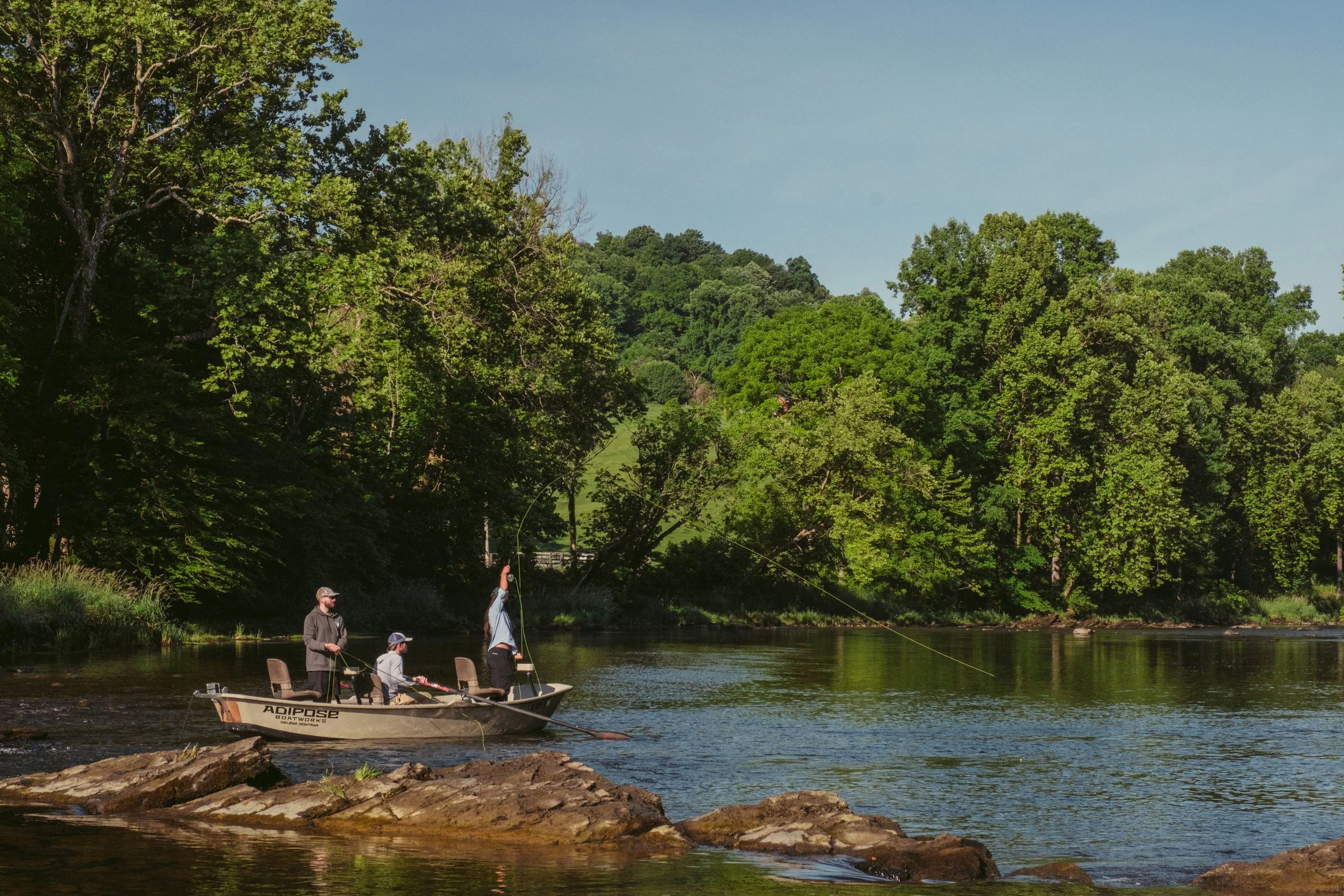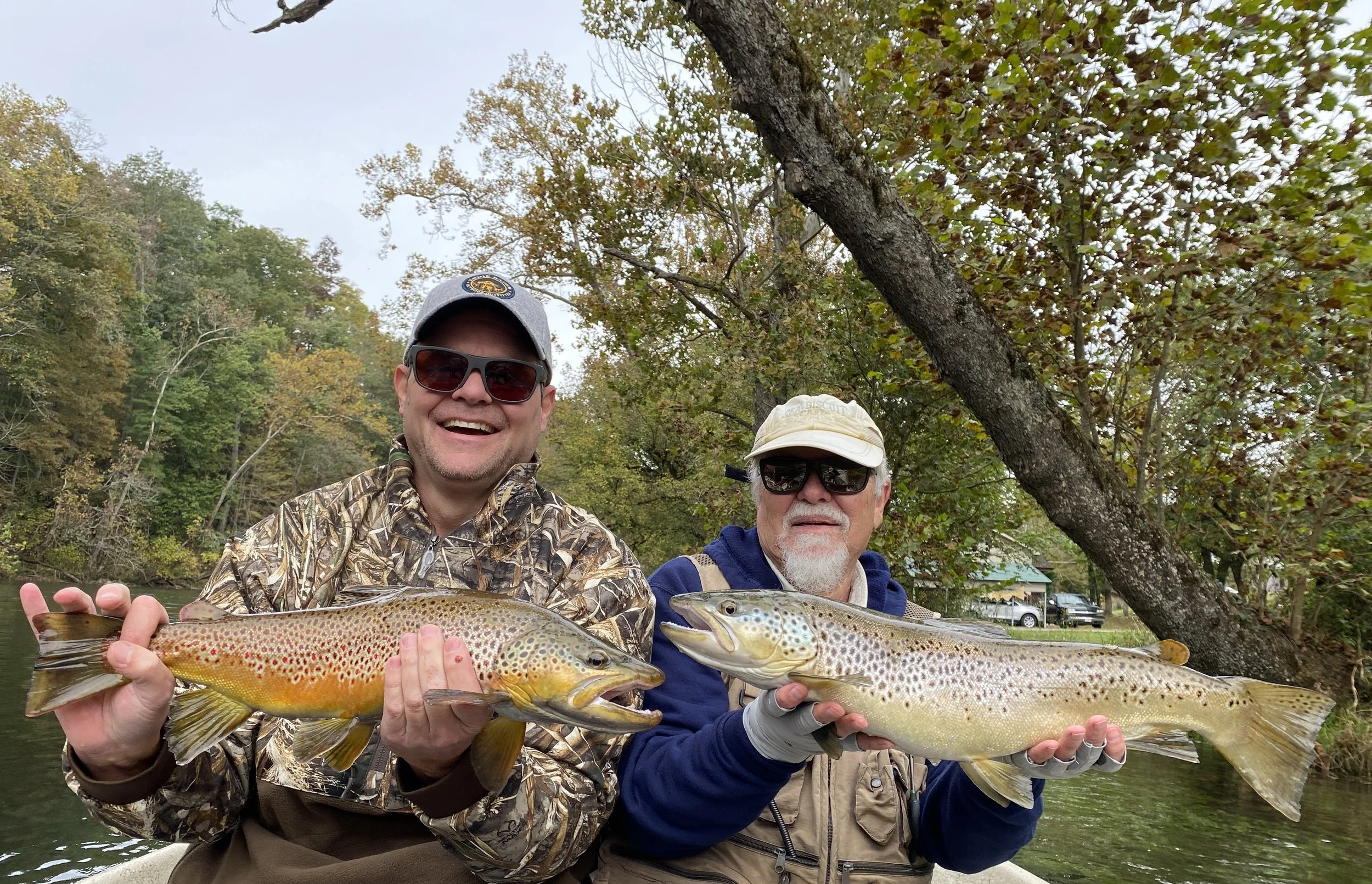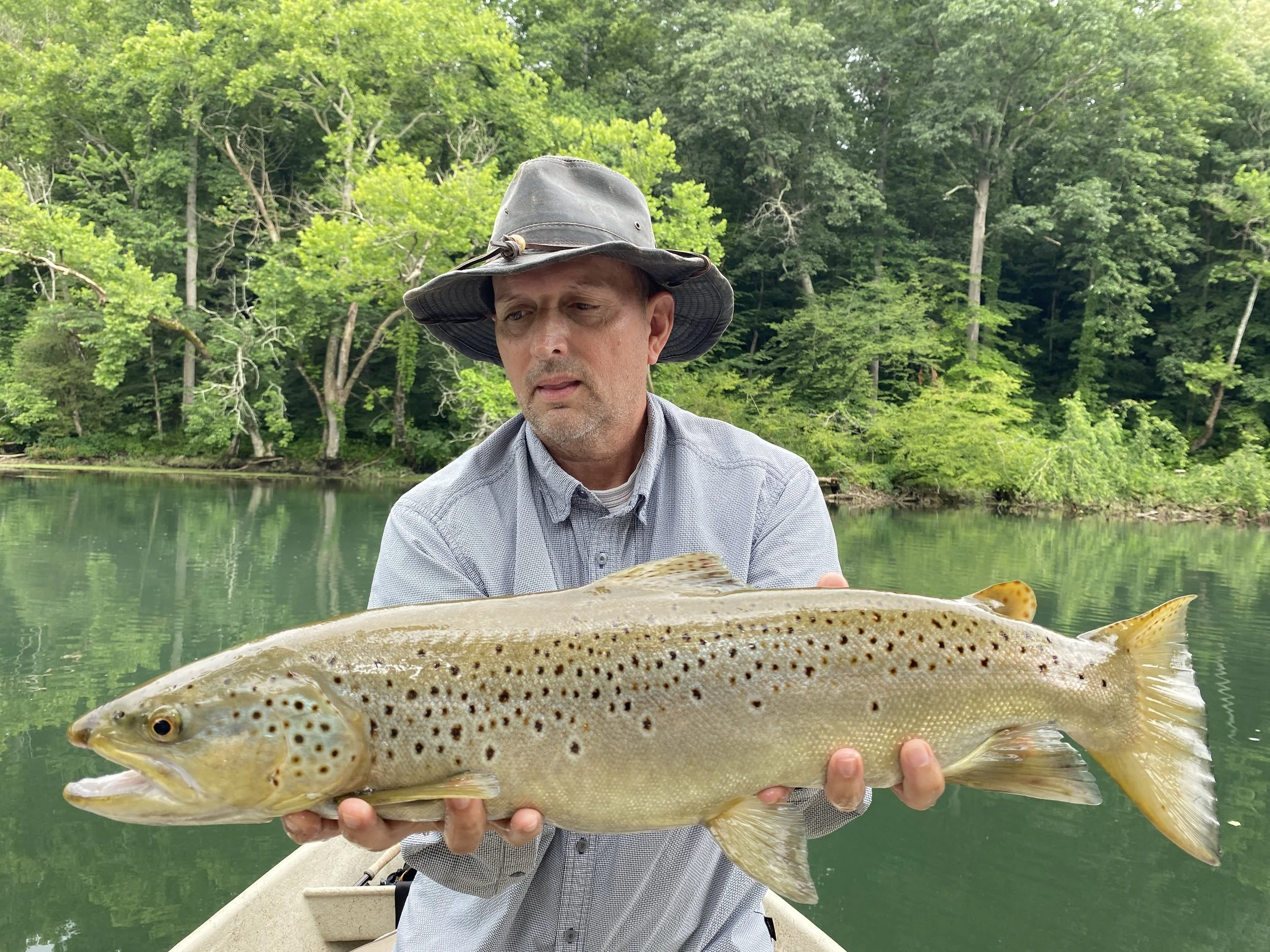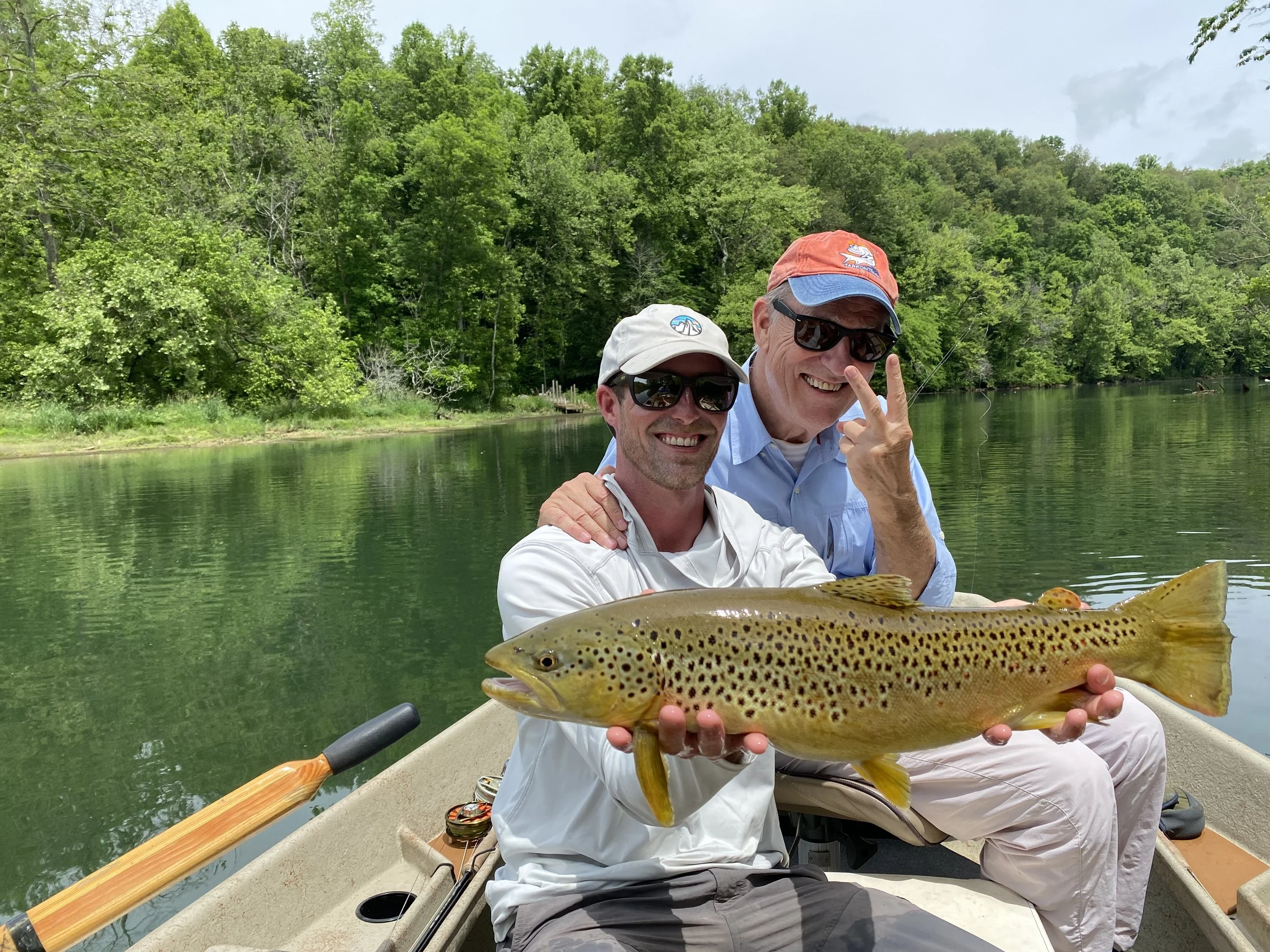South Holston Fly Fishing: A Complete Guide for Trout Anglers in Tennessee
The South Holston River is widely considered one of the top tailwaters in the Southeast for fly fishing, and for good reason. With reliable cold-water releases from the dam, a thriving population of wild brown and stocked rainbow trout, and consistent insect hatches, especially sulphurs, this Tennessee fishery offers year-round opportunities for anglers of all experience levels. Whether you're new to the river or looking to refine your approach, understanding how to effectively fish the South Holston is essential for success. In this guide, we’ll cover everything from the best seasons to fish and proven techniques, to gear recommendations, hatch strategies, and what to expect on a guided float trip with Appalachian Outdoors. If you’re serious about fly fishing in East Tennessee, this river deserves your attention and this guide will help you make the most of your time on the water.
Why the South Holston River Is a Premier Fly Fishing Destination
Location and River Overview
The South Holston River flows through northeast Tennessee, just outside the town of Bristol, and is known as one of the top tailwater fisheries in the Southeast. It begins below the South Holston Dam, where cold water is released from the bottom of the reservoir. This results in stable temperatures that support trout habitat throughout the entire year. The river runs for about 15 miles and includes a mix of deep pools, shallow riffles, and smooth runs. These varied conditions give anglers a chance to apply different techniques depending on water flow and trout behavior. The South Holston is also managed by the Tennessee Valley Authority (TVA), and anglers can plan their trips around predictable generation schedules. With multiple public access points and floatable sections, it is a convenient and reliable river to fish.
What Makes It Unique
Several factors make the South Holston River stand out. First is the trout population. Estimates show more than 6,000 trout per mile, with a strong mix of stocked rainbow trout and wild brown trout. The wild browns in particular are a highlight, often growing to impressive size and displaying selective feeding habits. The river is also known for its abundant aquatic insect life, which supports consistent hatches throughout the year. Sulphur mayflies and blue-winged olives are especially important here, providing some of the best dry fly fishing in the Southeast. Another key feature is the river’s clarity and flow consistency, which allow anglers to fish even in conditions that might shut down other waters. With reliable access, technical fishing opportunities, and a high fish count, the South Holston has earned its reputation as a premier fly fishing destination.
Best Time to Fly Fish the South Holston River
Seasonal Breakdown
Fly fishing on the South Holston River can be productive year-round, but knowing how each season affects water conditions, insect activity, and trout behavior can help anglers maximize success. It’s important to stay up to date with the South Holston River fishing report. Winter offers technical nymphing opportunities and consistent midge hatches, especially on warmer afternoons. While colder temperatures reduce insect variety, the low flows and clear water allow for precise presentations and sight-fishing for feeding trout.
Spring brings more active trout and a wider range of hatches. Blue-winged olives emerge more frequently, and increasing flows from spring rains can stir up feeding activity. During this time, anglers should be ready for both dry fly and nymphing conditions, adjusting based on generation schedules and clarity.
Summer is the most popular season due to the reliable sulphur hatch. These bugs come off nearly daily during peak months, especially in the afternoons. Dry fly fishing can be outstanding, but low water can also mean spooky fish and technical presentations. Fall transitions into a pre-spawn period for brown trout, who become more aggressive. Streamers and attractor nymphs can be productive, and changing leaf colors make for scenic days on the river.
Hatch Chart Basics
Understanding the hatch cycle is key to success on the South Holston. While sulphurs are the main draw during summer, the river sees a wide range of insect activity throughout the year. Midges are present year-round and are especially important in winter and low-water conditions. Small patterns in sizes 18 to 24, such as zebra midges, are reliable options for subsurface presentations.
Blue-winged olives appear heavily in early spring and again in the fall, typically in sizes 18 to 22. On overcast days, these hatches can trigger steady surface feeding, making dry fly fishing a good choice even outside of summer.
The sulphur hatch, which peaks from late spring through summer, is the most consistent and visible hatch on the river. Sizes range from 16 to 18, and emergers and spinners can both be effective. Caddisflies and craneflies also show up in small numbers, adding diversity to the diet of trout. Having a basic hatch chart and matching flies by size and color will help anglers stay dialed in throughout the season.
Fly Fishing Techniques That Work on the South Holston
Dry Fly Tactics for Selective Trout
Dry fly fishing is one of the most rewarding techniques on the South Holston, especially during sulphur and blue-winged olive hatches. The river’s wild brown trout are known for their selective feeding habits, which means anglers need to focus on proper presentation and fly choice. A drag-free drift is essential, especially during low flows when fish are holding in slow-moving seams or flat water. To achieve this, use long, fine leaders and light tippet in the 6X to 7X range. Positioning is also key—approach from downstream and use reach casts or slack-line techniques to reduce drag.
Fly selection should match the hatch not only in size and color but also in stage. During the sulphur hatch, for example, fish may key in on emergers or spinners more than duns. CDC patterns and comparaduns work well for picky risers, and switching to an emerger with a trailing shuck can often trigger a take when fish are ignoring traditional dries. Timing matters too, with the best dry fly action often happening in the late afternoon or early evening.
Effective Nymphing Setups
When surface activity is minimal, nymphing becomes the go-to technique for most anglers on the South Holston. With consistent cold flows and abundant subsurface insect life, trout feed below the surface the majority of the time. A standard indicator rig with a two-fly setup is effective in deeper runs and pockets. Use a size 16 or 18 sulphur nymph or pheasant tail as a point fly, followed by a small midge pattern on a dropper. Adjust weight and indicator placement to keep your flies near the bottom without getting snagged.
Tight-line or Euro nymphing methods are also highly effective on the SoHo, especially in lower water. These techniques give the angler direct contact with the fly, allowing for better strike detection and control over depth. Focus on seams, pockets behind rocks, and drop-offs where trout can sit just out of the current. With wild browns often holding in subtle lies, accurate casting and line control make all the difference. Even outside of hatch periods, nymphing remains a steady producer year-round.
Streamer Approaches
Streamer fishing on the South Holston can be productive, especially in the fall and winter when brown trout become more aggressive. It’s also a solid choice after rain or generation releases when water clarity is slightly off and fish are more willing to chase. Using a sink-tip line or adding split shot to your leader helps get the fly down in faster water or deeper runs. Focus on working banks, undercut areas, and structure like downed trees or submerged rocks.
Fly choice should include sculpin patterns, woolly buggers, and articulated streamers in natural colors like olive, brown, and black. In stained water, switching to brighter colors or patterns with flash can help increase visibility. Vary your retrieve—start with a slow strip and then mix in twitches or short bursts to trigger reaction strikes. Larger wild browns often feed during low-light hours, so early mornings and late evenings are prime times for streamers. Cover water methodically, and be prepared for aggressive takes when conditions are right.
Essential Gear for South Holston Fly Fishing
Recommended Rod and Reel Setup
A 9-foot fly rod in the 4 to 6 weight range is ideal for the South Holston River. A 5-weight rod offers the best all-around performance, providing enough finesse for technical dry fly fishing and enough backbone for light nymphing and handling larger trout. For anglers focused on small flies and delicate presentations during low water conditions, a 4-weight rod may be more appropriate. On the other hand, a 6-weight is helpful when throwing streamers or casting in windy conditions.
Pair your rod with a quality reel that has a smooth, adjustable drag system. While you may not need heavy drag pressure for smaller rainbows, wild browns can make long, strong runs, especially in faster water. A large-arbor design helps with quicker line pickup, which is useful when playing fish or managing slack line during drift adjustments. Choose a reel that balances your rod comfortably and holds both fly line and sufficient backing.
Leader, Tippet, and Fly Line Selection
Your leader and tippet setup can make or break your presentation on the South Holston. Most anglers use 9-foot tapered leaders for dry fly fishing, matched with 5X to 7X tippet depending on water clarity and fly size. In pressured areas or when fishing midges, 6X or 7X fluorocarbon offers the stealth needed to fool selective trout. For nymphing, consider using a shorter leader with added weight or a Euro nymphing leader for tight-line techniques.
Fly line selection should match your rod weight and fishing style. A weight-forward floating line is the most versatile choice and works well for both dries and nymphs. Look for lines designed for technical presentations if you’re focused on dry fly fishing. For those fishing streamers or deeper runs during higher flows, carrying a sink-tip line or using a sinking poly leader can help get your flies down quickly. Keep your lines clean and inspect leaders regularly to maintain performance and durability.
Must-Have Flies
The South Holston supports a wide range of insect life, so a well-stocked fly box is essential. Sulphur patterns are a must from late spring through summer. Include parachute sulphurs, comparaduns, and sulphur emergers in sizes 16 to 18. Blue-winged olive patterns, like sparkle duns and CDC dries, are effective in spring and fall, typically in sizes 18 to 22. Midge patterns are important year-round, especially in winter or during low water. Zebra midges, Top Secret midges, and small emergers in sizes 20 to 24 are reliable choices.
For subsurface fishing, pheasant tails, split-case sulphurs, and scuds are productive. A two-fly nymph rig with a heavier point fly and a small dropper covers multiple depths and food sources. When targeting bigger fish or during high flows, streamers like olive woolly buggers, sculpin patterns, and sparkle minnows can move aggressive trout. Rotating between patterns and adjusting size to match the hatch or water conditions is key to staying effective on the river.
Wade Fishing vs. Float Trips: Pros and Cons
Wade Access Points
Wade fishing on the South Holston is popular, especially when TVA is not generating water from the dam. The low flows expose more riverbed and create excellent opportunities to access prime holding water on foot. Several public access points allow anglers to spread out along the river, including spots near the weir dam, Osceola Island, and downstream pull-offs. These areas provide entry to riffles, seams, and tailouts where trout feed actively.
Wading allows for a slower, more methodical approach. Anglers can take time to observe fish behavior, match hatches, and fine-tune their presentations. It’s also more affordable and accessible for solo trips. The main challenge with wading is timing. Once the TVA starts generating, water levels rise quickly and can make wading unsafe or impossible. It’s critical to check flow schedules before heading out and remain aware of changing conditions while on the water.
Benefits of Guided Float Trips
Float trips offer a distinct advantage when fishing the South Holston, particularly during generation releases when wading is no longer an option. Guided float trips give anglers access to long stretches of water that are difficult or impossible to reach on foot. This means less fishing pressure, more active fish, and the ability to cover a wide range of habitats in a single day. With an experienced guide navigating the boat, anglers can focus fully on casting, presenting, and landing fish.
Appalachian Outdoors provides professional float trips on the South Holston with options for full or three-quarter days. These trips are well-suited for anglers of all experience levels. Beginners receive instruction and gear support, while experienced anglers can target technical spots with a skilled oarsman at the helm. Float fishing also offers the flexibility to switch between techniques based on the water type—nymphing in deeper runs, casting dries to rising fish, or stripping streamers near the banks. It’s a dynamic, efficient way to fish the river regardless of TVA generation schedules.
Safety and Etiquette on the South Holston
Reading Tailwater Flows
Fishing the South Holston requires a close eye on the Tennessee Valley Authority (TVA) generation schedule. As a tailwater, the river’s flow is controlled by dam releases, which can raise water levels rapidly and make wading dangerous. Before every trip, check the TVA’s generation forecast online or via phone. The river can go from safe to unsafe conditions in a matter of minutes once generation begins. Always know your exit points and never wade in unfamiliar areas during rising flows.
Even experienced anglers should carry a wading staff and wear a snug-fitting belt with their waders to reduce risk. Rising water not only increases current speed but also limits visibility and access to traditional holding water. If the siren at the dam sounds, or if water clarity begins to change quickly, exit immediately. Staying aware of your surroundings and monitoring the river's flow helps prevent accidents and ensures a safe day on the water.
River Etiquette
The South Holston is a popular river, and sharing the water respectfully makes the experience better for everyone. When wading, give others plenty of space—at least two full casts apart. If someone is fishing upstream or downstream, avoid stepping in directly across or entering their drift lane. Always ask before entering water near another angler, especially in tight areas or near productive runs. If you’re floating, pass behind wading anglers whenever possible and avoid casting into water they’re actively fishing.
Respect the direction others are working. Anglers moving upstream have the right of way over those fishing downstream. If you hook a fish, others should allow space until it’s landed. Avoid loud conversations, banging wading staffs, or splashing through pools. These actions can spook fish and disrupt nearby anglers. Small courtesies go a long way in maintaining a positive experience, especially during peak hatch periods when the river can become crowded.
Conservation and Fish Handling Tips
Catch and release is widely practiced on the South Holston, and proper fish handling is key to protecting the trout population. Always wet your hands before touching a fish to avoid damaging its protective slime layer. Use barbless hooks to simplify release, and carry a rubber net to reduce stress during landing. Keep the fish in the water as much as possible, especially during warm months when oxygen levels are lower.
When releasing trout, point them upstream and let them recover before letting go. Avoid fishing when water temperatures exceed 70 degrees, as it can increase mortality even with careful handling. Be mindful of spawning redds in the fall—these are shallow, cleared gravel areas where trout lay eggs. Avoid walking through or fishing directly over them to protect future generations. Practicing responsible fishing and conservation helps ensure the South Holston remains a top-tier fishery for years to come.
Hiring a Fly Fishing Guide for the South Holston
What a Local Guide Brings to the Table
Booking a guide for the South Holston River is one of the best ways to shorten the learning curve and make the most of your time on the water. Local guides know the river’s structure, trout behavior, and TVA generation schedules inside and out. They can put you in productive water whether you're floating high flows or targeting risers during low water. A seasoned guide also has a firm grasp on current hatches and fly selection, helping you adjust quickly to changing conditions.
In addition to knowledge, a guide brings the right gear and tools to help you succeed. From custom-tied flies to purpose-built drift boats, everything is dialed in to fish this specific tailwater. Their experience allows you to focus on casting and presentation rather than logistics. Whether you're new to fly fishing or looking to refine a specific skill, a day with a local expert often delivers results and insight you wouldn't gain on your own.
What to Expect on a Guided Trip
A typical guided trip on the South Holston begins with a safety briefing and an overview of the day’s plan based on water flows and weather. If you're doing a float trip, your guide will launch the drift boat and position it strategically as you move down the river. Most guided floats last a full or three-quarter day, covering several miles of water and offering access to productive stretches that are unreachable by foot. All necessary gear—rods, reels, flies, leaders—is usually provided, but you can also bring your own.
Expect detailed instruction on techniques like casting, mending, and setting the hook. The guide may adjust your rig based on water depth, hatch activity, or how fish are feeding. Breaks are built into the trip for snacks, lunch, and rest. Most guides will help with fish handling and photos, ensuring a low-stress experience for both angler and trout. Whether you're focused on numbers or hunting big wild browns, your guide tailors the day to your goals and skill level.
Frequently Asked Questions About South Holston Fly Fishing
What is the best time to fly fish the South Holston River?
The best time to fly fish the South Holston is late spring through summer, especially during the famous sulphur hatch. That said, the river offers year-round opportunities thanks to consistent cold-water releases from the dam. Winter and early spring are great for midge and blue-winged olive hatches when crowds are lighter.
Can you wade fish the South Holston River?
Yes, the South Holston offers excellent wade fishing during low water conditions when the TVA isn’t generating. Several public access points provide entry to productive riffles and runs. Always check the generation schedule before wading, as flows can rise quickly and create unsafe conditions.
What kind of trout are in the South Holston River?
The river is home to wild brown trout and stocked rainbow trout, with a healthy mix of sizes throughout. Brown trout in particular thrive in this tailwater, often reaching 20 inches or more. The combination of consistent water temperatures and abundant insect life makes it a top trout fishery.
Do I need a guide to fish the South Holston River?
While it’s possible to fish the South Holston on your own, a local guide can significantly improve your success. Guides know the river’s flow patterns, hatch cycles, and best access points, especially during TVA generation. A guided float trip also allows you to reach less-pressured water.
What flies work best on the South Holston River?
Sulphur patterns in sizes 16–18 are essential during late spring and summer. Midges, blue-winged olives, and scuds are productive year-round, especially during winter and early spring. Having a variety of emergers, nymphs, and dry flies in smaller sizes will prepare you for most conditions.
How do I check the water flow on the South Holston River?
You can check the water flow by visiting the TVA’s Lake Info website or using the TVA app. Look for the South Holston Dam generation schedule to see when water releases are planned. This helps you determine whether conditions are suitable for wading or better suited for a float trip.
Plan Your South Holston Fly Fishing Trip Today
The South Holston River stands out as one of the best year-round fly fishing destinations in the Southeast, offering consistent flows, rich insect life, and a strong population of wild and stocked trout. Whether you prefer stalking rising fish with dry flies or drifting nymphs through deep runs, the SoHo delivers a range of opportunities for all skill levels. We’ve covered the best times to fish, key hatches, effective techniques, essential gear, and the advantages of both wade and float fishing. Safety and etiquette are also important to ensure a rewarding experience for everyone on the water.
If you're ready for fly fishing in Tennessee, let Appalachian Outdoors help you make the most of it. Our experienced guides offer professional float trips on the South Holston tailored to your goals and skill level. Book your trip today and experience what makes this river a true fly fishing destination.





